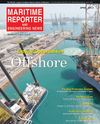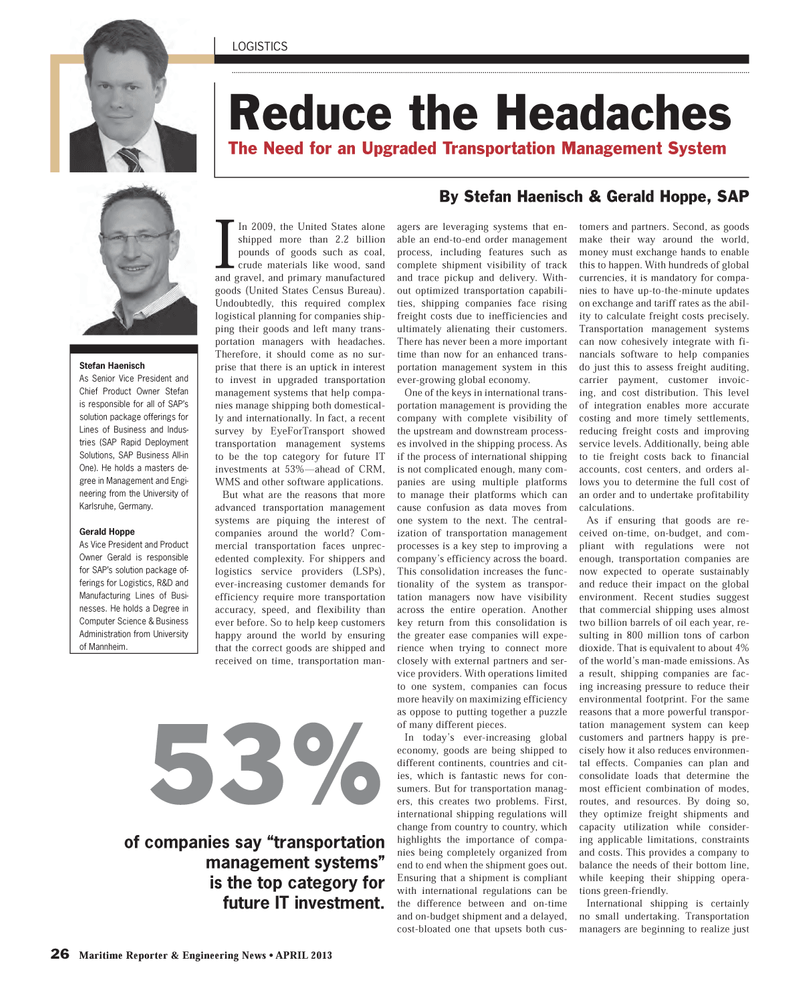
Page 26: of Maritime Reporter Magazine (April 2013)
Offshore Energy Edition
Read this page in Pdf, Flash or Html5 edition of April 2013 Maritime Reporter Magazine
26 Maritime Reporter & Engineering News ? APRIL 2013 IIn 2009, the United States alone shipped more than 2.2 billion pounds of goods such as coal, crude materials like wood, sand and gravel, and primary manufactured goods (United States Census Bureau). Undoubtedly, this required complex logistical planning for companies ship-ping their goods and left many trans-portation managers with headaches. Therefore, it should come as no sur- prise that there is an uptick in interest to invest in upgraded transportation management systems that help compa-nies manage shipping both domestical-ly and internationally. In fact, a recent survey by EyeForTransport showed transportation management systems to be the top category for future IT investments at 53%?ahead of CRM, WMS and other software applications.But what are the reasons that more advanced transportation management systems are piquing the interest of companies around the world? Com-mercial transportation faces unprec-edented complexity. For shippers and logistics service providers (LSPs), ever-increasing customer demands for efficiency require more transportation accuracy, speed, and flexibility than ever before. So to help keep customers happy around the world by ensuring that the correct goods are shipped and received on time, transportation man-agers are leveraging systems that en-able an end-to-end order management process, including features such as complete shipment visibility of track and trace pickup and delivery. With- out optimized transportation capabili-ties, shipping companies face rising freight costs due to inefficiencies and ultimately alienating their customers. There has never been a more important time than now for an enhanced trans-portation management system in this ever-growing global economy. One of the keys in international trans-portation management is providing the company with complete visibility of the upstream and downstream process-es involved in the shipping process. As if the process of international shipping is not complicated enough, many com-panies are using multiple platforms to manage their platforms which can cause confusion as data moves from one system to the next. The central- ization of transportation management processes is a key step to improving a company?s efficiency across the board. This consolidation increases the func-tionality of the system as transpor- tation managers now have visibility across the entire operation. Another key return from this consolidation is the greater ease companies will expe-rience when trying to connect more closely with external partners and ser- vice providers. With operations limited to one system, companies can focus more heavily on maximizing efficiency as oppose to putting together a puzzle of many different pieces. In today?s ever-increasing global economy, goods are being shipped to different continents, countries and cit- ies, which is fantastic news for con-sumers. But for transportation manag-ers, this creates two problems. First, international shipping regulations will change from country to country, which highlights the importance of compa-nies being completely organized from end to end when the shipment goes out. Ensuring that a shipment is compliant with international regulations can be the difference between and on-time and on-budget shipment and a delayed, cost-bloated one that upsets both cus-tomers and partners. Second, as goods make their way around the world, money must exchange hands to enable this to happen. With hundreds of global currencies, it is mandatory for compa-nies to have up-to-the-minute updates on exchange and tariff rates as the abil- ity to calculate freight costs precisely. Transportation management systems can now cohesively integrate with fi-nancials software to help companies do just this to assess freight auditing, carrier payment, customer invoic-ing, and cost distribution. This level of integration enables more accurate costing and more timely settlements, reducing freight costs and improving service levels. Additionally, being able to tie freight costs back to financial accounts, cost centers, and orders al-lows you to determine the full cost of an order and to undertake profitability calculations. As if ensuring that goods are re-ceived on-time, on-budget, and com-pliant with regulations were not enough, transportation companies are now expected to operate sustainably and reduce their impact on the global environment. Recent studies suggest that commercial shipping uses almost two billion barrels of oil each year, re- sulting in 800 million tons of carbon dioxide. That is equivalent to about 4% of the world?s man-made emissions. As a result, shipping companies are fac-ing increasing pressure to reduce their environmental footprint. For the same reasons that a more powerful transpor- tation management system can keep customers and partners happy is pre-cisely how it also reduces environmen-tal effects. Companies can plan and consolidate loads that determine the most efficient combination of modes, routes, and resources. By doing so, they optimize freight shipments and capacity utilization while consider- ing applicable limitations, constraints and costs. This provides a company to balance the needs of their bottom line, while keeping their shipping opera-tions green-friendly. International shipping is certainly no small undertaking. Transportation managers are beginning to realize just LOGISTICSReduce the HeadachesThe Need for an Upgraded Transportation Management System Stefan Haenisch As Senior Vice President and Chief Product Owner Stefan is responsible for all of SAP?s solution package offerings for Lines of Business and Indus-tries (SAP Rapid Deployment Solutions, SAP Business All-in One). He holds a masters de-gree in Management and Engi- neering from the University of Karlsruhe, Germany. Gerald HoppeAs Vice President and Product Owner Gerald is responsible for SAP?s solution package of- ferings for Logistics, R&D and Manufacturing Lines of Busi-nesses. He holds a Degree in Computer Science & Business Administration from University of Mannheim.By Stefan Haenisch & Gerald Hoppe, SAP53%of companies say ?transportation management systems? is the top category for future IT investment. MR #4 (26-33).indd 26MR #4 (26-33).indd 264/1/2013 1:44:56 PM4/1/2013 1:44:56 PM

 25
25

 27
27
